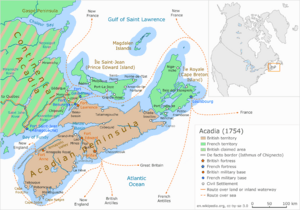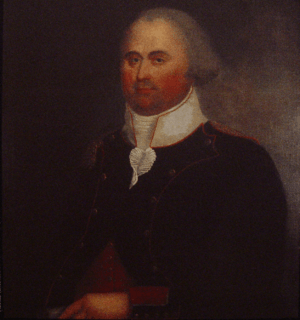Ile Saint-Jean campaign facts for kids
Quick facts for kids Ile Saint-Jean campaign |
|||||||
|---|---|---|---|---|---|---|---|
| Part of French and Indian War | |||||||
 Isle Saint-Jean before the deportation |
|||||||
|
|||||||
| Commanders and leaders | |||||||
| Andrew Rollo, 5th Lord Rollo | Gabriel Rousseau de Villejouin Charles Deschamps de Boishébert et de Raffetot |
||||||
| Units involved | |||||||
| 40th Regiment of Foot Roger's Rangers |
Acadia militia Wabanaki Confederacy (Maliseet militia and Mi'kmaq militia) |
||||||
The Ile Saint-Jean campaign was a series of military actions in the fall of 1758. It happened during the Seven Years' War. The main goal was to move Acadians from Ile Saint-Jean (now Prince Edward Island). Many Acadians lived there, or had come there to escape earlier forced removals.
Lieutenant-Colonel Andrew Rollo led 500 British soldiers. This group included James Rogers and his Rangers. They were sent to take control of Ile Saint-Jean.
This campaign was one of the deadliest for Acadians. Many people died during this forced removal. It was the second largest deportation of Acadians, after the one in 1755.
Contents
Why the Campaign Happened

The British took control of Nova Scotia in 1710. This happened after the Conquest of Port Royal. The Treaty of Utrecht changed things for the Acadians. They could either leave Nova Scotia or promise loyalty to the British.
Many French settlers and Acadians moved to Ile Royale after 1713. Ile Royale, also called Cape Breton Island, was a French colony. It included Ile Royale and Ile Saint-Jean. Ile Saint-Jean was important for farming. Its rich land made many Acadians choose to settle there.
The Acadian mainland (now New Brunswick), Cape Breton Island, and Isle Saint-Jean stayed under French control. For 45 years, Acadians refused to fully promise loyalty to Britain. During this time, Acadians helped fight the British. They also kept important supply routes open to French forts like Louisbourg.
During the Seven Years' War, the British wanted to stop the Acadians. They wanted to remove any military threat. They also wanted to cut off supplies to Louisbourg. So, they decided to deport Acadians from Nova Scotia.
Ile Saint-Jean became more and more Acadian over time. Its population grew a lot from 1749 to 1755. It quadrupled to about three thousand people. This made Ile Saint-Jean a key part of the Acadian community.
Reasons for Deportation
The British Lieutenant Governor, Charles Lawrence, made a big decision. On July 28, 1755, he and the Nova Scotia Council decided to deport the Acadians. This happened after Acadians refused to promise loyalty to the British Crown.
One reason for the Ile Saint-Jean campaign was to deport Acadians. This would make space for English and Scottish settlers. Another reason was to remove any possible resistance. This was important before the British planned to attack Quebec the next year.
It's thought that about 11,500 out of 14,100 Acadians were deported. Many Acadians died during this process. This made it one of the deadliest British campaigns of the Expulsion.
The first wave of these deportations began in 1755. This was after Father Le Loutre's War. Many Acadians fled these operations. They went to the French colony of Ile Saint-Jean. Gabriel Rousseau de Villejouin was the major and commander there. He sometimes sent Mi'kmaq people to Nova Scotia. They would raid and bother the English.
After the British captured Louisbourg in 1758, they started more deportations. They removed Acadians from Ile St. Jean, Ile Royale, and New Brunswick. This second wave was even more difficult and damaging than the first.
The Campaign Begins

On July 26, 1758, Governor Augustin de Boschenry de Drucou surrendered Louisbourg to the British. This changed everything for the people on Ile Saint-Jean. A few days later, the British made it clear that all people on Ile Saint-Jean would be deported.
The defeated French governor sent officers to Ile Saint-Jean. They told the people and military about the surrender and deportation.
General Jeffery Amherst ordered Lieutenant-Colonel Andrew Rollo to lead the deportation. Rollo was to take Ile Saint-Jean. He was also to build Fort Amherst at Port-la-Joye. Then, he would deport the Acadians.
On August 8, 1758, Rollo sailed for Ile Saint-Jean. He had 500 men on four ships. These ships were the King of Prussia, Dunbar, Bristol, and Catherine.
Taking Control of the Island
On August 17, Rollo's ship, the Hind, arrived at Port-la-Joye. A boat with a white flag came out to meet them. Soon after, the fort surrendered. Gabriel Rousseau de Villejouin, the commander, gave up the island.
Villejouin knew the British were coming. He had heard about the fall of Louisbourg. On August 18, Rollo's men went up the Hillsborough River. They brought back French prisoners and cannons.
Rollo expected about 400 to 500 people. But he found ten times that number. French officials and military were taken first. This made it easier for the deportation to continue. The first group of 692 people left on August 31.
People had to give themselves up and hand over their weapons. Those who did were taken to Louisbourg. From there, civilians were sent to Europe. Military men were sent to England.
Acadians Resist and Escape
Not everyone on the island followed British orders. A letter from Rollo on October 10 said many had fled to Canada. They took a lot of cattle with them. Another letter said troops had trouble getting people to surrender. An armed ship was helping people escape.
Rear Admiral Philip Durell sent Captain Maximillian Jacobs to destroy that ship. Some Acadians went to a refugee camp in Miramichi. This camp was unknown to the British. It sheltered Acadians escaping deportation. However, conditions there were very bad. Many people died from disease and hunger.
Some Acadians hid in the island's forests for years. They lived off wild game and lost livestock. Nicolas Gautier helped settlers escape from the north shore. His family was well-known for opposing the British.
The Deportation Continues
On October 14, a ship arrived at Port-la-Joye. It carried Noel Doiron and 50 other Acadians. On October 20, Doiron and his family boarded the ship Duke William. This ship later had a terrible fate.
About 3,000 people were deported. Roughly 600 had been sent to Ile Royale earlier. Then they were sent across the Atlantic on the Mary. Almost half of the people on the Mary died from disease. Historian Earle Lockerby thinks 255 out of 560 passengers died.
Two other ships, the Sukey and Mary, took 600 prisoners to St. Malo, France. The Mary carried prisoners from Ile Saint-Jean. The other ship carried people from Louisbourg and Ile Royale. Fourteen other ships were also used for deportation from Ile Saint-Jean.
By the end of October, British efforts to deport prisoners were almost done. On October 30, a ship master reported 1,600 people had been put on ships. About 600 settlers remained for the winter. These were mostly women, children, and the sick.
On November 4, 12 transport ships left Port-la-Joye. One ship, the Ruby, was wrecked in the Strait of Canso. Another was wrecked near the Azores. The Duke William and Violet sank off Land's End. Eight ships made it to France.
In total, about 1,500 Acadians died on their way to France. They died from disease or drowning.
All settlers from the largest village, Havre Saint-Pierre, were deported. Acadians were also deported from Port-la-Joye, Bedec, La Traverse, Riviere des Blonds, and Riviere au Crapeau. Other settlements in Kings County, Prince Edward Island were also cleared.
While most Acadians surrendered, about 1,250 (30%) did not. Many of them fled the island. The French and Acadians used four ships to help people escape. These ships were at Malpec (now Malpeque Bay, Prince Edward Island). Malpec was far from British patrols.
Acadians managed to reach a refugee camp called "Camp de l'Espérance." This camp was led by French military leader Charles Deschamps de Boishébert et de Raffetot. It was on Beaubears Island near Miramichi, New Brunswick. Acadians also reached Baie des Chaleurs and the Restigouche River.
On the Restigouche River, Jean-François Bourdon de Dombourg had another camp. It was called Petit-Rochelle. Acadians Joseph Leblanc and the brothers Pierre and Joseph Gautier helped many people escape. The Mi'kmaq also helped some Acadians.
Families from Malpec, Tracadie, and Étang des Berges seem to have avoided deportation. Many families from the rivière du Nord-Est also went to Ristigouche with the Gauthiers, Bujolds, and Haché-Gallants.
By mid-1759, about 150 Acadians remained on the island. Unlike other campaigns, the British did not burn villages here. Rollo was told to save the homes for future British settlers.
Some Acadians started arriving in French ports by November. Officials reported that the deportees had lost everything they owned. Many died on the journey across the ocean. At least three ships were destroyed. The Ruby ran aground, killing 103 Acadians. The Duke William and Violet sank, leading to about 756 deaths.
What Happened Next
After the Ile Saint-Jean campaign, Major General Amherst sent Brigadier James Wolfe to the coast. This was part of the Gulf of St. Lawrence campaign (1758). After Wolfe left, the 1760 Battle of Restigouche happened. Several hundred Acadians were captured at Boishébert's camp.
The British also went along the northern shore of Baie Françoise (now Bay of Fundy). In November, Major George Scott destroyed villages along the Petitcodiac River. This included Beausoleil. At the same time, Colonel Robert Monckton led a similar campaign on the St. John River. The British also had a similar campaign at Cape Sable campaign.
Sadly, some people from Ile Saint-Jean were deported a second time. They had been deported from the mainland in 1755. Then they were shipped to the Carolinas. They had returned from there before Rollo's forces arrived.
The exact number of people from Ile Saint-Jean is not known. This is because many died or escaped. The deportation of Acadians in 1758 was the start of a long journey for them. Acadians ended up in places like France, the Caribbean, Louisiana, and St. Pierre.


